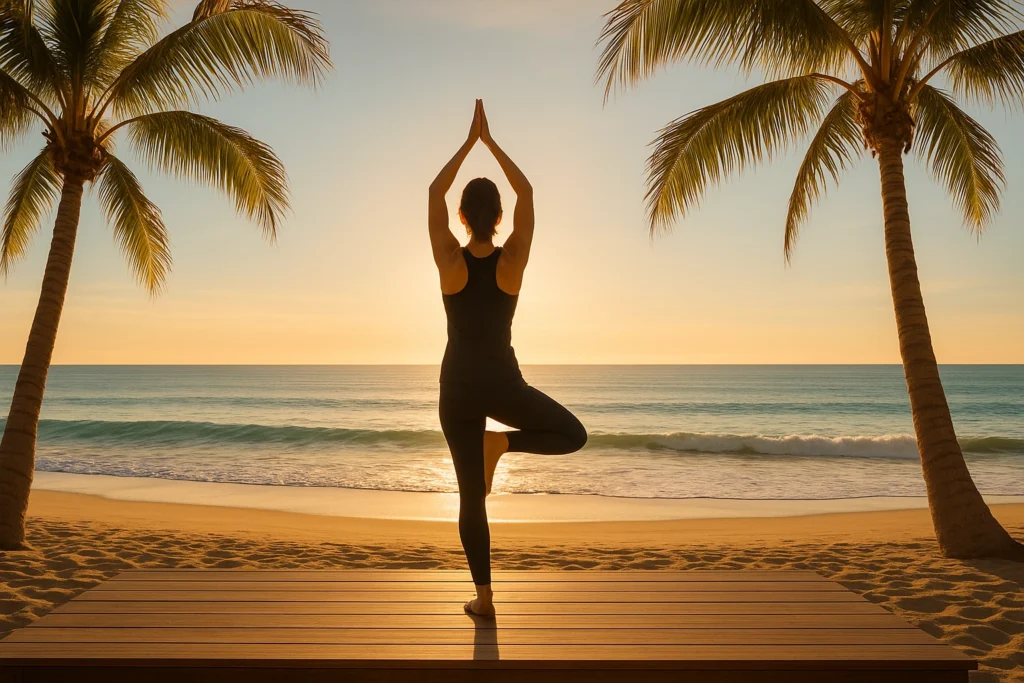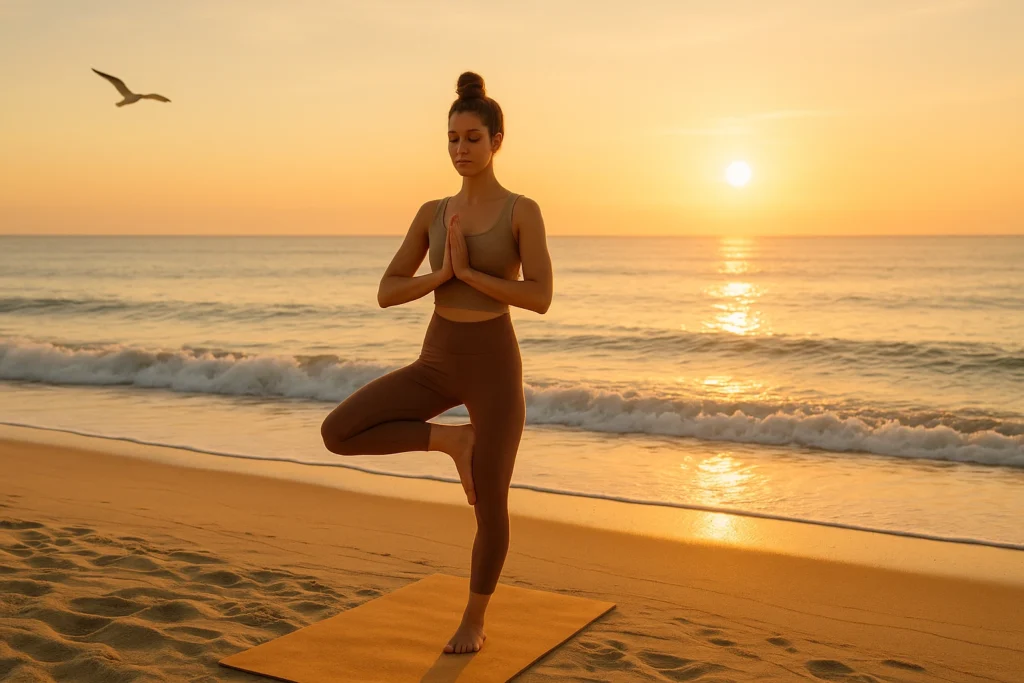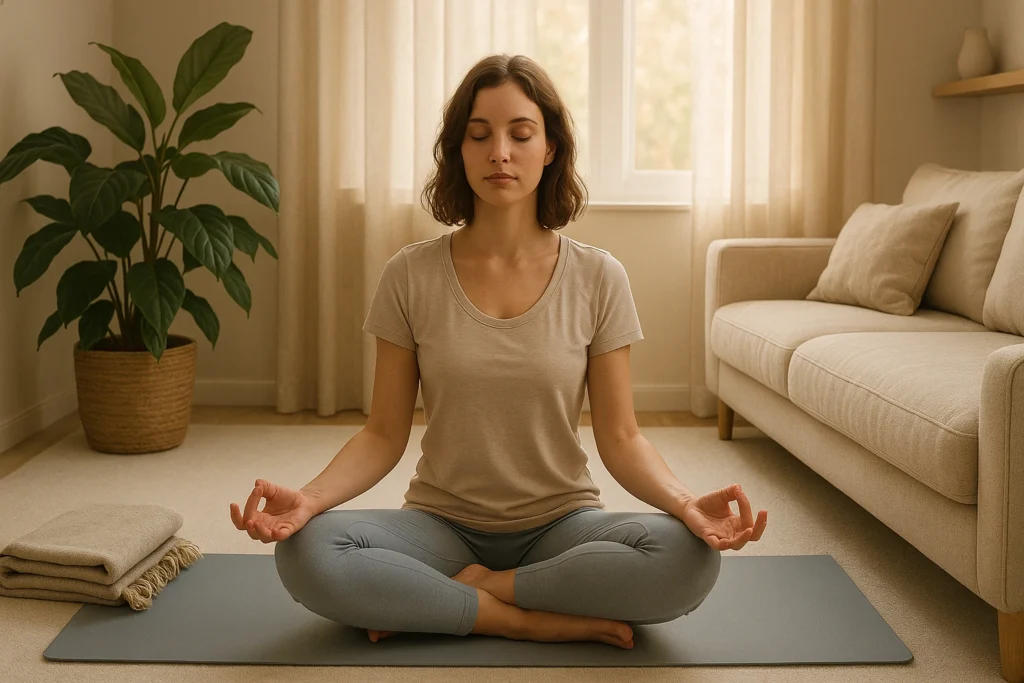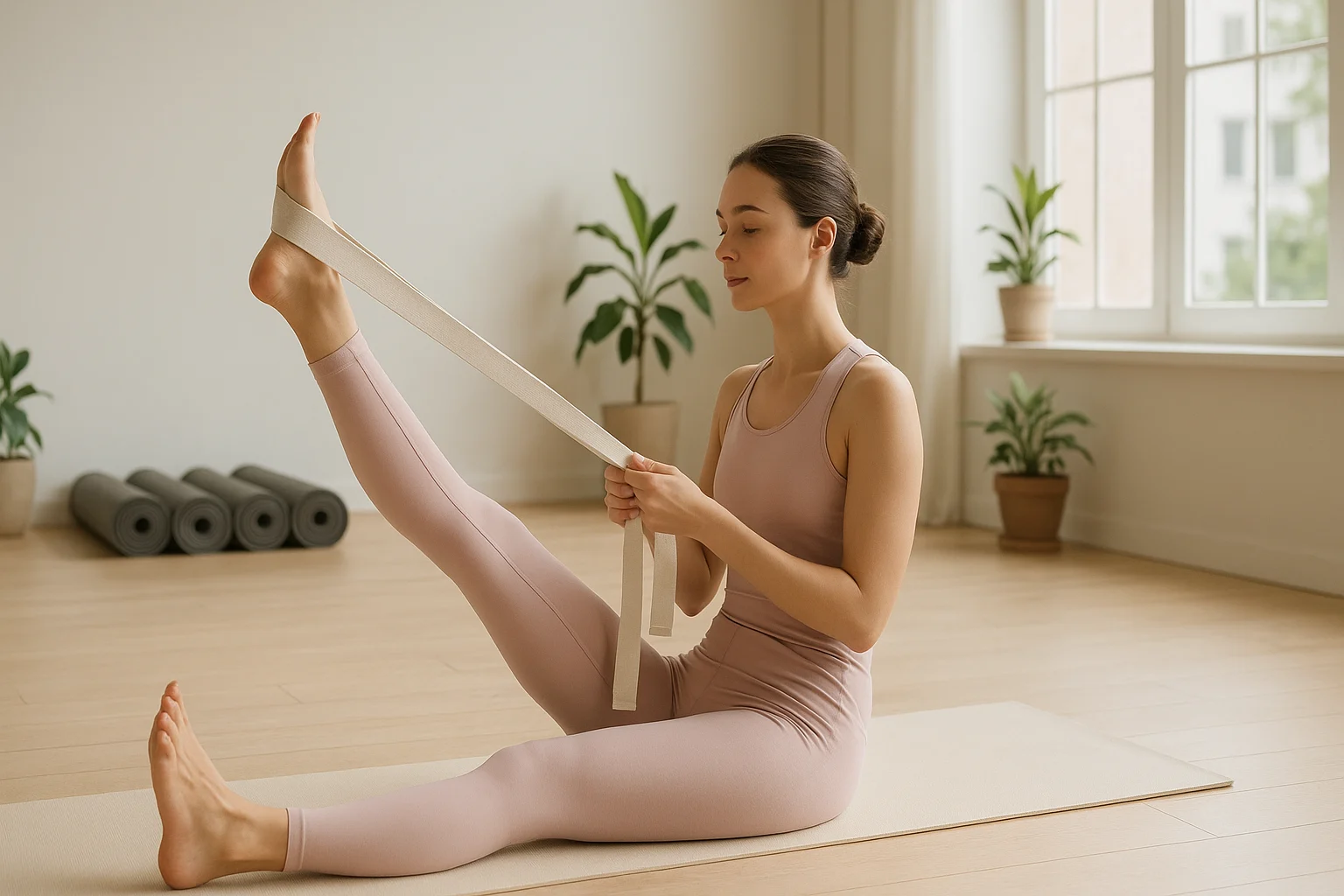
Ever catch yourself straining for your toes or wishing you could settle a little deeper into a pose? It turns out a simple tool can open shapes you thought were out of reach. A yoga strap for flexibility can steady your practice—useful whether you’re brand-new or years in. Indeed, this humble tool acts like an extension of your arms, helping you stretch deeper, align better, and move with ease. For a complete foundation on improving flexibility — from props like straps to easy routines — check out our yoga flexibility guide. With steady, mindful practice over a few weeks, many people notice looser hamstrings, easier shoulders, and less hip tension. So, let’s explore how simple yoga strap stretches can safely take your practice to the next level.
Start Tracking Your Flexibility!This page contains paid/affiliate links. As an Amazon Associate we earn from qualifying purchases, and we may earn commissions from other partners—at no extra cost to you. Links marked with ‘#ad’ are affiliate links, meaning we may earn a commission at no extra cost to you. Learn more.
Table of Contents
Key Takeaways for Using a Yoga Strap for Flexibility
- Using a yoga strap, you can finally reach a little further — getting into deeper stretches without straining.
- It’s especially helpful for opening up tight spots like your hamstrings, shoulders, and hips, so progress feels gradual and safe.
- It also supports healthy posture, helping you avoid the common issues that come from poor alignment.
- Use it regularly and you may notice your range of motion expand while stiffness eases.
- Just remember: move slowly, breathe deeply, and never push past your comfort zone.
Why a Yoga Strap for Flexibility Is a Secret Weapon
I still remember my first attempt at touching my toes — my hamstrings were so tight it felt like they were pulling back with all their might. Everything shifted once I started using one. Suddenly, I could ease into stretches without that painful tug. So, what makes this simple strap such a game-changer? Here’s why.
Essentially, a yoga strap bridges the gap between where you are and where you want to be in your practice. Here are the top six benefits:
- Extends your reach: Can’t grab your toes in a forward fold? A strap lets you reach your feet without hunching, targeting the right muscles.
- Deepens stretches safely: By providing gentle leverage, this tool helps you ease into poses, reducing injury risk.
- Improves alignment: No more rounding your back to reach. The strap keeps your spine long and shoulders relaxed.
- Assists in challenging poses: A strap makes shapes like Dancer’s more approachable so you can work on strength and balance without overreaching.
- Reduces strain: Instead of fighting the stretch, the strap gives you support, helping your muscles settle so progress comes more easily.
- Provides consistent tension: Where hands can slip, the strap keeps an even feel so you can stay in the stretch comfortably and for longer.
Moreover, a strap can support proprioceptive neuromuscular facilitation (PNF), a technique that alternates contraction and relaxation and may help improve flexibility over time. For more on PNF and stretching, check out this Harvard Health article.
“A yoga strap isn’t a crutch; it’s a bridge to deeper understanding and connection with your body’s potential.”
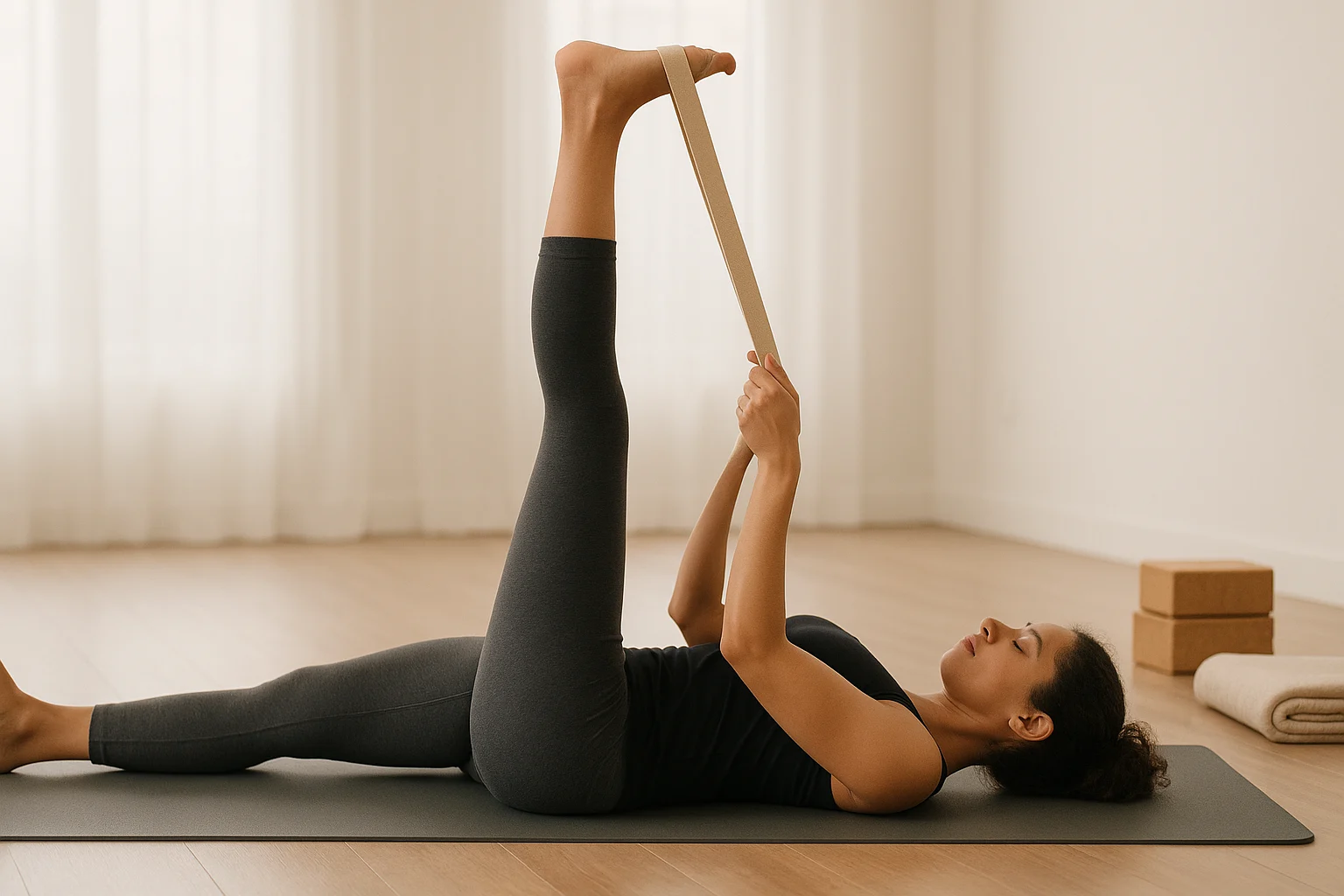
Choosing Your Perfect Yoga Strap
Choosing a strap isn’t complicated, but a few details do make a difference. Here’s what to look for:
- Material: Cotton (e.g., Manduka) feels grippy and eco-minded, though it can wear with heavy use. Nylon/poly (e.g., Gaiam) is tougher if you practice often.
- Length: Common sizes are 6, 8, and 10 ft. If you’re newer or tighter through the legs, 8–10 ft gives you extra reach.
- Buckle type: D-rings are very secure (a bit slower to adjust). Cinch styles tweak faster but can slip. Quick-release is rare and best for fast flows.
- Body size: If you’re taller or working with limited range right now, a 10-ft strap makes poses like Reclining Leg Stretch easier to set up.
In short, a sturdy cotton or nylon strap with a D-ring buckle works well for almost any practice — and it’s a fantastic companion if you’re exploring different yoga prop stretches, whether you’re brand-new or experienced.
Helpful tools for strap work
One reliable strap is all you need. If you’re tall or very tight, choose a 10-ft length for extra reach.
Product: Manduka AligN Yoga Strap
Premium cotton with a secure zinc-alloy buckle — grippy, comfy, and dependable for daily practice. 8 ft suits most; 10 ft for extra reach.
Safety First: Preparing to Use Your Yoga Strap
Before you start stretching with a strap, safety is key. Here’s how to prepare:
- Warm-Up: Spend 5-10 minutes on light cardio (e.g., walking, jumping jacks) or dynamic movements (e.g., leg swings) to warm your muscles.
- Listen to Your Body: If you feel sharp or pinchy sensations, ease off right away.
- Breathe deeply: Inhale to prepare; exhale to explore a little more. Breath-holding adds tension, so keep it smooth.
- Be gentle: Skip any tugging. Slow, steady work builds more reliable change.
- Maintain alignment: Think long spine and easy shoulders so the right areas are doing the work.
Keep these tips in your back pocket, and you’ll be ready to try out yoga prop stretches that can gently but surely support your flexibility.
Yoga Strap Exercises for Flexibility
Now it’s time to explore some of the most effective strap exercises. These moves focus on your hamstrings, shoulders, and hips — the areas that tend to hold the most tension. At first, your hamstrings might feel stubborn; with steady, regular practice they usually soften and feel more comfortable.
Hamstring Stretches for Flexibility
Tight hamstrings can contribute to discomfort, including lower back strain for some people. Using a yoga strap for deeper flexibility support makes these stretches accessible and effective. To further ease back tension, try complementary poses from our guide on yoga for lower back pain.
Reclining Leg Stretch (Supta Padangusthasana Variation)
Benefits: Stretches hamstrings, calves, and hips. Supports the spine, ideal for beginners.
How to Do It:
- Lie flat on your back with legs extended — bend your left knee and place your foot flat if your lower back feels tight.
- Loop it around the arch of your right foot, grabbing each end with a hand.
- Slowly extend your right leg toward the ceiling, keeping it relaxed with a soft knee. Imagine lengthening your leg like you’re reaching for the sky.
- Tug it lightly to bring your leg closer, keeping your arms straight and hips anchored to the mat.
- Stay here for 30-60 seconds, breathing slow and deep, letting the stretch feel good.
- Lower gently and switch to the left leg.
Prop Tip: If your leg feels far from your chest, hold the strap closer to your foot and adjust as you get more flexible.
Common Mistake: Don’t let your hips lift off the mat — keep your lower back grounded.
Seated Forward Fold (Paschimottanasana Variation)
Benefits: Stretches hamstrings, spine, and shoulders. Calms the mind.
How to Do It:
- Sit with your legs stretched out in front, toes pointing up like you’re flexing your feet toward the sky.
- Wrap it around the balls of your feet, holding an end in each hand.
- Take a deep breath to sit tall, then exhale as you hinge forward from your hips, bringing your belly toward your thighs.
- Pull gently to deepen the stretch, keeping your spine long and avoiding any rounding in your back.
- Hold for 30-60 seconds, breathing smoothly to relax into it.
- Sit up slowly, feeling refreshed.
Prop Tip: If your hamstrings are tight, sit on a folded blanket to help tilt your pelvis forward.
Common Mistake: Avoid rounding your back — think about hinging at your hips instead.
Yoga Prop Stretches: Quick Tips
Keep prop-supported stretches gentle and steady: warm up first, stay within a comfortable range, and use it to guide posture rather than force depth.
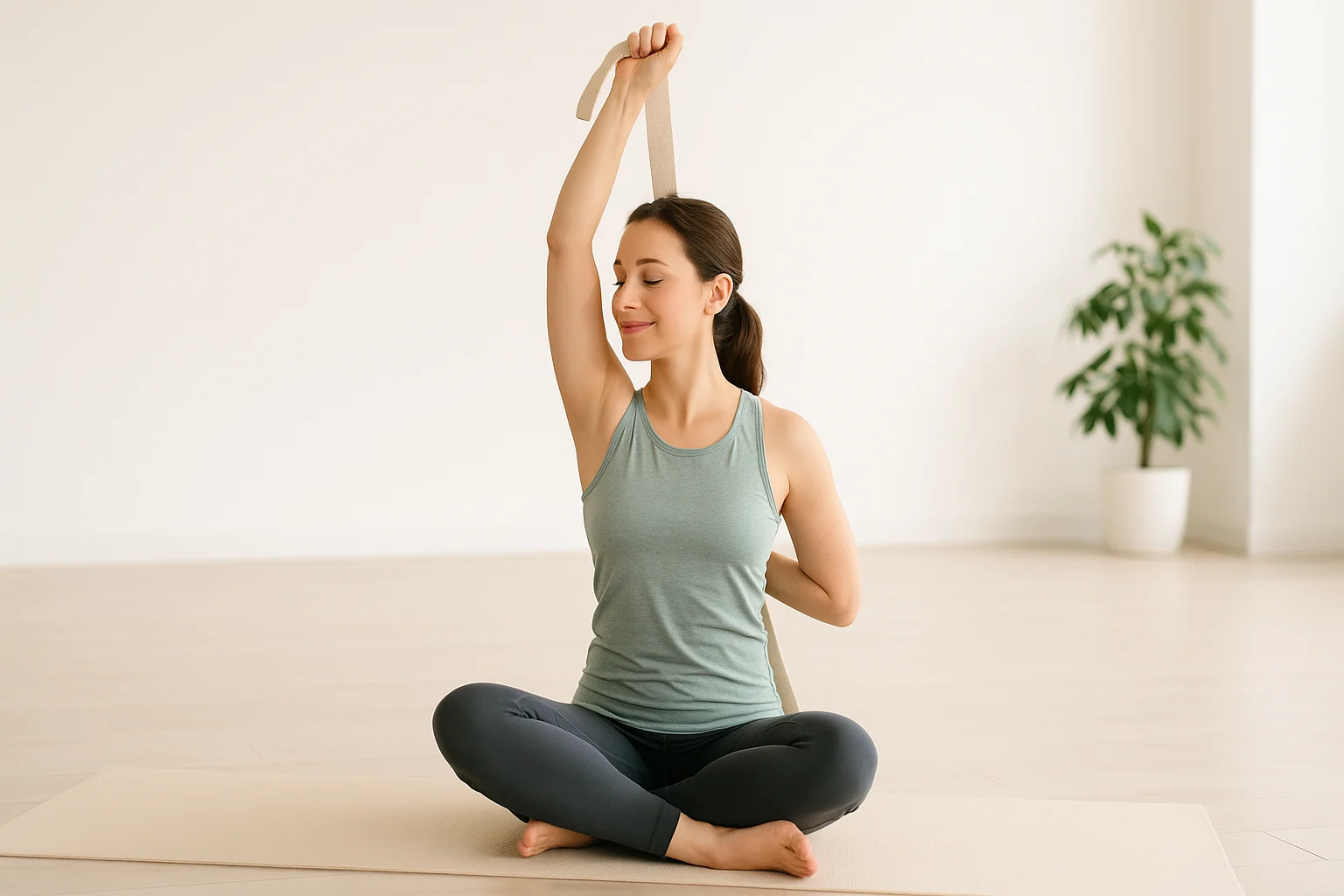
Shoulder Stretches for Flexibility
A yoga strap for flexibility opens the chest and shoulders, improving posture and mobility. If you experience wrist discomfort during these stretches, explore our yoga wrist stretches for added relief.
Cow Face Pose Arms (Gomukhasana Variation)
Benefits: Stretches shoulders, triceps, and chest. Enhances posture.
How to Do It:
- Sit comfortably, cross-legged or in a way that feels good for you.
- Hold it in your right hand, lift it up, and bend your elbow to let it drape down your back.
- Reach your left arm behind you, bending it to grab the end with your fingers.
- Slowly walk your hands closer together along it, keeping your chest open and spine tall like you’re standing proud.
- Hold for 30-60 seconds, breathing deeply to let your shoulders relax.
- Switch sides with care.
Prop Tip: If your hands can’t get close, grip the strap tightly and inch closer over time.
Common Mistake: Don’t hunch your back — keep your spine straight and relaxed.
Shoulder Pass-Through / Floss
Benefits: Increases shoulder mobility, opens the chest.
How to Do It:
- Stand or sit tall, holding a yoga belt with both hands, palms down, a bit wider than your shoulders.
- Lift it up and over your head, then back behind you, keeping your arms straight and chest lifted.
- Bring it back to the front smoothly, repeating 5-10 times. As you get more flexible, try narrowing your grip slightly.
Prop Tip: If it feels tough, widen your grip to avoid strain and keep the motion fluid.
Common Mistake: Don’t bend your elbows or shrug your shoulders — stay loose and relaxed.
Hip Stretches for Flexibility
More flexible hips may improve daily movement and comfort for many people. A strap makes these stretches gentle.
Dancer’s Pose (Natarajasana Variation)
Benefits: Stretches chest, shoulders, thighs; improves balance.
How to Do It:
- Stand tall, shifting your weight onto your left foot, feeling steady.
- Loop it around your right ankle, holding both ends in your right hand.
- Lift your right foot behind you, pressing into it to open your chest like you’re soaring.
- Extend your left arm forward for balance, pulling the strap to deepen the stretch in your thigh and chest.
- Hold for a few calm breaths and keep your hips even, easing off if you feel sharp pain.
- Switch sides with ease.
Prop Tip: This prop helps with balance and reach, especially if your shoulders are tight.
Common Mistake: Don’t lock your standing knee — keep it soft for stability.
Reclined Pigeon Pose (Eka Pada Rajakapotasana Variation)
Benefits: Stretches outer hips and glutes; may help with sciatic-like discomfort for some people; if you have diagnosed sciatica, consult a healthcare professional.
How to Do It:
- Lie on your back with knees bent, feet flat on the mat, feeling grounded.
- Cross your right ankle over your left thigh to make a figure-four shape.
- Loop it around your left thigh, holding both ends with your hands.
- Pull to bring your left knee toward your chest while gently pressing your right knee away, feeling your hip gently release with each breath.
- Hold for 30-60 seconds, keeping your back flat and breathing deeply.
- Switch sides smoothly.
Prop Tip: This prop lets you deepen the hip stretch without straining your neck or shoulders.
Common Mistake: Don’t let your lower back lift — keep it pressed into the mat.
Beyond the Mat: Everyday Benefits of a Yoga Strap
Using a yoga strap isn’t just for yoga. It can enhance daily movement:
- Easier Movement: Bending to pick up items or reaching high shelves may feel smoother.
- Less Stiffness: Prolonged sitting can feel less taxing with looser hips and shoulders.
- Fewer Aches: Improved flexibility may reduce tension in the back and neck.
- Better performance: Runners, cyclists, and other athletes may notice smoother range of motion when they add gentle yoga sequences.
Even 5–10 minutes a day goes a long way. Keep at it and you’ll likely feel everyday movement get easier, with steady gains in flexibility with straps.
Track Your Flexibility Journey with a Yoga Strap
Want to watch your progress? Use this simple tracker to check in on different body areas. Pick the option that fits—“Very Tight” through “Flexible & Comfortable”—and you’ll get small, targeted tips.
| Body Area | Current Flexibility Status |
|---|---|
| Hamstrings | |
| Shoulders | |
| Hips | |
| Spine | |
| Overall Flexibility |
Select your flexibility status for personalized tips!
Frequently Asked Questions About Yoga Straps
Embrace Your Yoga Strap, Embrace Your Stretch!
A yoga strap for flexibility is more than a tool—it’s your partner in unlocking new levels of mobility and comfort. By making it part of your regular routine, you’ll build lasting flexibility with straps and reduce daily tension. To continue progressing beyond strap work, explore our complete yoga flexibility guide — your all-in-one resource for poses, props, and routines that deepen your practice safely. Grab your mat and this simple prop, find a quiet space, and start stretching today. Your body will thank you!
